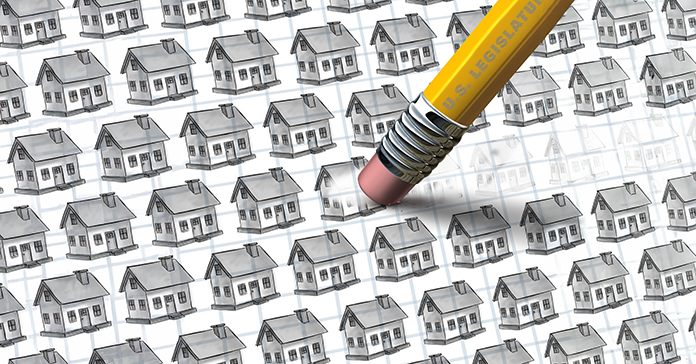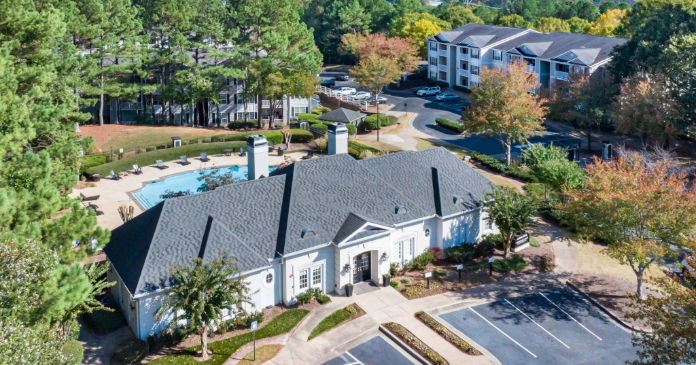Windows, along with doors and skylights, are almost always the weak link in a building’s envelope. They can account for 35 to 40 percent of a unit’s heat loss and an even higher percentage of heat gain in warm weather. However, new technology has greatly improved their energy efficiency, which–according to a recent survey by Reed Research Group, a nationally known research firm and division of Reed Business Information–is the most important criterion among those who purchase, specify or recommend new and replacement windows for multifamily communities. Nearly 75 percent said energy performance was a primary concern in window selection, followed by quality (73 percent), cost (70 percent), durability (69 percent) and aesthetics (around 63 percent).
One of the least important in the survey’s list of nine criteria was environmental attributes. Only 17 percent of those surveyed found green attributes a compelling choice factor. Nor was brand name a huge draw. Just 27 percent chose windows for multifamily projects based on brand. More important was the comprehensiveness of a manufacturer’s website. Nearly 70 percent of survey respondents said the Internet was their main source for product information, followed by product literature (53 percent). Sales reps came in third at 46 percent.
The common measures of a window’s energy efficiency are its ability to insulate (U-factor), block solar heat (solar heat gain coefficient (SHGC) and resist heat flow (R-value), the latter of which only applies to certain parts of the window, like the frame or center of the glass.
Both U-factor and SHGC are based on a scale of zero to one, with the lower number representing greater insulating ability of the product. Window shoppers should look for a U-factor of 0.30 or less and a SHGC of 0.50 or less.
While some window and door manufacturers use their own rating systems, the National Fenestration Rating Council (NFRC), a non- profit, public/private organization comprised of window, door and skylight manufacturers, suppliers, builders, architects and designers, specifiers, code officials, utilities and government agencies, provides consistent ratings on these products and lists U-factor and SHGC on its labels.
Other indicators of efficiency include emissivity, or how well the surface of glass radiates heat, and air leakage/infiltration rate, which is measured by cubic feet per minute (cfm) and refers to air leakage through cracks in the window’s assembly. The lower the cfm number, the less air will pass through the window area.
Features like gas fillings, low-E coatings and multiple glazings that now are commonly available from most window manufacturers also enhance windows’ energy efficiency and provide a barrier to noise pollution, but proper installation is as important to energy efficiency as U-factor and SHGC.
Sound barrier
When it comes to providing a barrier to unwanted sound, Sound Transmission Class (STC) is the industry standard rating. “Noise has become a big concern and something we are asked to address a lot,” said Jeld-Wen Product Manager Brian Hedlund, who points out that infill sites close to airports, rail lines and major highways are coming on the radar of more multifamily developers as developable land becomes increasingly scarce. These developers are faced with finding solutions to offset the ever increasing noise resulting from living in close proximity to transportation systems.
The higher STC ratings for windows are achieved through the actual glass package or the construction of the window in terms of how weather-tight it is. The standard glass package, said Hedlund, is two pieces of the same thickness.
“We found that differential glass thicknesses help break up the sound wave even more. We also work to optimize the air space between the two pieces of glass, which has a big effect on sound transmission. But above and beyond thicknesses, we can do other things with the glass that will enhance the STC rating even further, such as going to laminated glass. That’s the biggest step you can take to see an improvement in the STC rating,” said Hedlund.
Laminated glass also is a major component of impact-resistant windows. The idea for their use came from the automotive industry, where laminated glass has been used on the front windshield to protect occupants.
When the wind blows
Structural damage from hurricanes is largely caused by failures of doors and windows that can result in roof collapse and interior wall failure. Before impact-resistant glass entered the residential market 20 years ago, shutters were the only protection against flying debris and breaches in the building envelope during a storm. Today, much of that damage can be prevented, say window manufacturers, by installing impact-resistant windows.
The key components in impact-resistant windows are laminated glass, the framing system and sealant. Laminated glass, which consists of two layers of glass with a plastic sheet or film in the middle, stays in one piece even when cracked.
The inter-layer is most important because if an opening is created by flying debris, the highly pressurized air can rush in and actually blow the roof off a structure and cause the building to collapse. Appropriate inter-layers, which vary from .015 inch to .090 inch in thickness, should vary according to the size of the glass and window type. When the inter-layers work properly, even if the glass cracks under pressure, the fragments adhere to the inter-layer, minimizing the danger of falling or flying glass.
Design pressure (DP) is the rating system for window and door resistance to positive and negative air pressure, wind and rain. Hurricane-resistant windows must pass rigorous large- and small- missile impact tests, during which the glass must survive an impact without being penetrated. This testing is standard in the industry, and is set forth by the American Society for Testing & Materials (ASTM).
“When we test our windows, we fire an eight- or nine-foot long, two- by four-inch thick piece of wood out of an air cannon and smash it into the window. The window can crack but cannot have a void that allows air to rush in,” said Mark Gallant, Atrium VP of marketing and new product development.
Codes differ from state to state and region to region. Beginning in July 2001, the South Florida Building Code required that every exterior opening in a house be protected against flying debris, either by shutters or impact-resistant windows, and must meet requirements for large and small missiles. Those specifications are what led to the standard of industry performance testing conducted today.
“When you get down in Dayton-Broward Counties and Miami in South Florida, where winds are in excess of 140 mph, product has to be more stringently built to pass the highest degree of code and product performance,” said Gallant, noting that some manufacturers design and build their windows to meet the Dayton Broward County specs and know their products will be fine for everybody else.
Atrium Companies, which focuses on aluminum and vinyl frames and only dabbles with wood in California, just launched a fully comprehensive line of vinyl impact-resistant windows under its Safe Harbor trademark. Atrium is one of many such companies to roll-out such products recently.
Anderson debuted its Storm Watch series this year, and Weather Shield claims the new storm-resistant windows offered in its ELS vinyl window line exceed DP ratings of 50. Simonton’s StormBreaker Plus vinyl windows combine impact-resistant laminated glass with double- strength tempered glass. Jeld-Wen broadened its offering of storm- resistant wood, vinyl and aluminum windows this year with ImpactGuard Protection windows that provide a .090-inch inner layer touted as 100 times more rigid than the industry standard and delivering five times the tear strength. Hi-Lite Products introduced the StormBlocker window at the 2007 International Builder’s Show in Orlando earlier this year, claiming that product achieved a 90 DP rating, giving it enough strength to withstand wind speeds of up to 230 mph when tested on a 50-inch by 90-inch acrylic block window.
Expect more impact-resistant products to debut as code enforcement in storm-prone areas outside of South Florida becomes more stringent.
With the 2007 hurricane season upon us, properties from Texas to Maine are at risk. It’s way too late to add protection this year, but owners and operators of multifamily communities should prepare now for 2008, if they don’t get blown away.
















